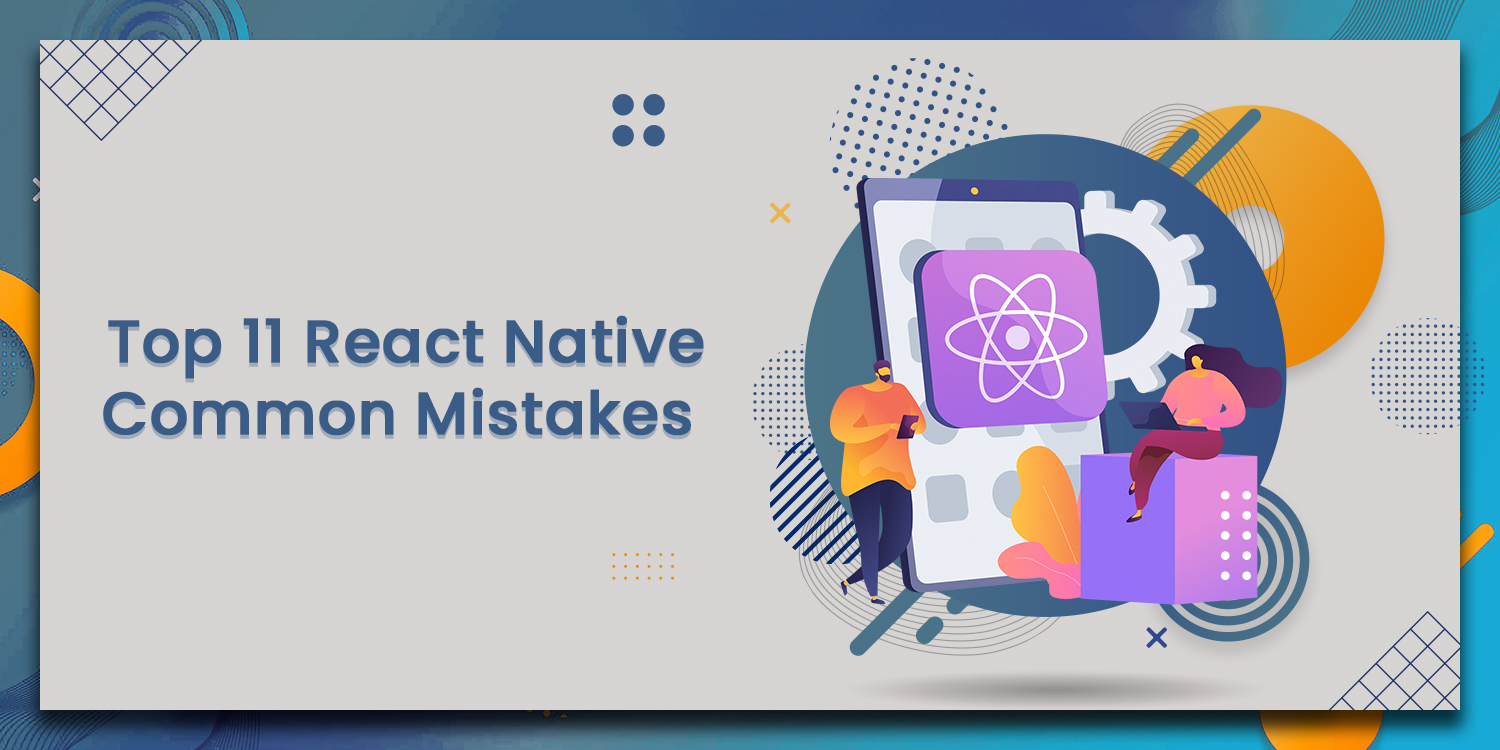React Native is one of the most powerful technologies for creating cross-platform applications. The way apps are built has been drastically transformed by its ability to employ JavaScript to create functional and aesthetically beautiful applications for iOS and Android. But even the most experienced React Native app development company could require assistance to use this framework.
To give you the resources you need to be successful in your React Native development projects, we’ve put up a list of the top 11 errors that developers make most frequently. You can ensure the delivery of excellent apps, streamline your development process, and give your target audience an impeccable user experience by being fully aware of these potential issues. With the knowledge in this tutorial, you will be able to steer clear of frequent pitfalls and advance your React Native app development service toward success. Together, we will explore best practices and gain confidence in navigating the React Native ecosystem.
Table of Contents
ToggleMarket Demand for React Native Platform
As of now, React Native is one of the biggest front-end software for development. If we look at the stats, 42.62% of engineers believe that React is one of the best frameworks for developing mobile apps and domains. Additionally, Flutter is the most used framework for development, but it has some limitations and inbuilt templates, which limits the ability to design unique apps. Therefore, React Native has no limitations, and it can add multiple extension tools, which make it easier to create new designs and action buttons in apps. Overall, it completely depends on the demands of the client, as they may want to hire a React Native app development company or a Flutter app development company.
Why Do Developers Choose React Native for Development?
1. Cross-Platform Development:
React Native allows developers to write code once and deploy it to both iOS and Android platforms. It significantly reduces development time and costs compared to building separate native apps for each platform. Therefore Developers call React the best cross-platform app development framework.
2. Leverage JavaScript Expertise:
Many developers are already experts in JavaScript. React Native allows them to utilize their existing skills to build mobile apps. It reduces the learning issues for developers. Now, a coder will use their expertise to create an app through JavaScript through React.
3. Quicker Development and Hot Reloading:
React Native’s component-based architecture facilitates code reuse and speeds up development. The hot reloading feature speeds up the development cycle and boosts productivity. It allows developers to see code changes in the application with one click.
4. Native-like Performance:
React Native apps employ native UI components to create a smooth and responsive user experience. It is reminiscent of native apps, even if they are not fully native.
5. Big Developer Ecosystem and Community:
React Native has a sizable and vibrant developer community. It means that developers can create complicated app features faster and with more functionality by using easily accessible resources, frameworks, and plugins.
6. CI/CD friendly:
React Native works nicely with CI/CD solutions, enabling more rapid app deployment cycles and optimized development workflows.
7. Live Reloading:
React Native’s live reloading functionality allows developers to see their code changes reflected in the app instantly without having to restart or recompile it. It is in contrast to typical app development methods. Additionally, it facilitates faster iteration and greatly increases development efficiency.
8. Open-Source and Facebook-Supported:
The framework’s open-source nature enables developers to contribute to its development and adapt it to meet specific requirements. Furthermore, Facebook’s sponsorship guarantees continued improvement, assistance, and a sizable community actively participating in the framework’s expansion.
Top 11 React Native Apps Development Mistakes
It is not just the limitation vested into the framework, and sometimes the blunders also prove to be the challenge while constructing any app. So here is an overview of some commonly accepted react native errors.
1. Wrong Estimation:-
The first error comes when any developer forgets or skips the layout terminology. The layout for iOS app development or Android app development can be different. Other than that, there might be possibilities that the developer may find reusable components.
Following error comes in the forms. Any developer must also prefer the layout validation because any developer who builds any app in the react-native needs to write many codes. It does not happen when apps are constructed on a Hybrid or other platform.
Moreover, the team can look out for the backend team’s loose ends (if any). Simultaneously, it is necessary to maintain all such logic hence code accuracy is the master key. The developer must understand the database structure to avoid React native app development mistakes.
2. Disappropriate Image Optimization:-
Image optimization is a crucial step in terms of application development. Speaking of, many developers skip or neglect this crucial step. Ignorance of such mistakes leads to a high chance of getting misaligned images in the final delivery.
Similarly, the load time on the website also increases if the images are not well-optimized. In addition, optimization helps compress the images in short sizes, which boosts the website’s speed and user stability.
3. Misaligned Redux Store Planning:-
A developer is always expected to create something new in any project. But sometimes, planning the layout and leaving loose ends on the data handling give major or minor react native application development mistakes.
Redux store planning ensures that the data remains safe and sound on the directories. Simultaneously, it untangles the app rates and performs data management efficiently. So when anybody skips the redux store planning, you may lose the app functionality.
4. An Eye On Module Code:-
This is not a new phenomenon for the developer to utilize external modules for time-saving on development. It makes things work flawlessly and provides the required pace when coming along with documentation.
Keeping in mind the general react-native mistakes, the module may not work as expected. This is why any developer first reads the code and then considers it as the flow of react-native best development practice.
5. Mutation Process:-
Any qualified developer knows how the data store and views are interconnected. A data store is a way to keep the data in components. Similarly, the view is rendered based on state. After that, it consumed a new form from the datastore and displayed it on the screen.
All of the processes come under the umbrella known as the “Life cycle.” Now, if the data mutation happens directly, the developer has messed up the life cycle. Not only this, it corrupts the entire previous state. When this happens, the app so developed behaves abnormally and, in some cases, even crashes.
6. Working With Stateless Component:-
With the emergence of React Native16, developers working on the old grounds must change their development techniques. Because with the release of react native16, the earlier procedures have become stateless components.
Stateless components are the components that cannot expand any class further. Before reacting native16, these were utilized, but now it’s high time developers must stop this practice. Instead, they should utilize pure components to avoid any react-native mistakes.
7. Left “console.log” Statement:-
Console log statements are the best friends of any developer. It provides help in debugging the app execution. In many react native development mistakes, it is found that the log statement has remained in the app.
It, in return, gives serious issues when logic and render methods are kept inside. Especially when there is a threat of a bottleneck in the JavaScript thread, this mistake can cause the application to become slower.
8. Writing Unit Test:-
The practice of doing development without noting down the unit tests is a big react-native error. The unit test is not adequately documented and can put your app at risk of drowning in the IT sector.
It is a big React native apps development blunder because any error or bug is hard to resolve once an app is ready to launch. Moreover, if developers do not resolve the error, it impacts the entire functionality of the application.
9. Attention to Protocols:-
Avoiding the fundamental protocols while reacting to native app development can cause considerable harm to your final app. Therefore, it is advised that the developer and designer both follow the best practices to avoid any discrepancies.
React native is why it is considered the top-notch platform for building apps. It is an ocean of best practices that any development team must follow. Simultaneously, following the standard protocol will tamper with the overall development process.
10. Avoiding the Project Structure:-
The team of developers never overlook or ignore the actual project layout in any circumstances. Instead, the developer must deploy their spare time to learn about the project details.
Avoiding any single lead or detail on the project will lead your app to sink into the water. A well-organized structure allows any React native app development company to give its best and receive the best outcome from the client.
11. Coding Skills:-
Coding skills are something that deals directly with the presentation and functionality of the React native app. Utilizing the latest trends, techniques, and formats will yield fruitful results. There are many functions and skills one cannot avoid like:
- Using Array instead of manually managing strings.
- Vital doms must begin with the “render” command.
- Variables & React elements should be in PascalCase.
- Events methods must flinch with “on” to show it is attached.
- Pure JS code should be ignored.
- Codes must be used with complete accuracy.
- The primary render method must involve JSX.
Planning to hire a React Native Developer?
Conncet with our professional Team
Conclusion
Avoiding these common blunders is essential to successfully navigate the React Native app development process. Developers may guarantee a simplified development experience by following best practices in image optimization, encouraging transparent and consistent communication, and creating well-defined procedures. This results in improved user experience, improved application speed, and a project that is well-positioned for success. Through the prioritization of a robust foundation in React Native principles and the cultivation of a collaborative approach, developers may effectively utilize this powerful framework to produce remarkable mobile apps.
FAQs
1. Is React Native the right choice for my mobile app?
React Native is a powerful framework, but it’s not a one-size-fits-all solution. Consider these factors:
- App Complexity: React Native might be ideal for simpler apps. However, highly complex apps with intricate native features might benefit more from native development.
- Development Team Expertise: If your team lacks JavaScript or React experience, a steeper learning curve exists with React Native.
- Performance Requirements: For apps requiring peak performance or extensive device-specific functionalities, native development might be better suited.
2. Will React Native limit my app’s performance?
While some performance overhead exists with React Native compared to truly native apps, it’s often negligible for most applications. Modern development practices and optimizations can further minimize this difference. React Native app development solution excels in delivering a smooth user experience for a wide range of app functionalities.
3. I have an existing web app. Can I reuse code with React Native?
Absolutely! A significant advantage of React Native is code reusability. You can leverage your existing JavaScript codebase from your web app to build the core logic of your mobile app, saving development time and resources.
4. What about access to native device functionalities in React Native?
With React Native’s extensive library of native modules, you can incorporate device-specific functionalities like Bluetooth, GPS, and cameras into your app. You may still create native code snippets to fill in the functionality that current modules do not currently cover.
5. Is React Native a good choice for long-term app maintenance?
Mature and well-established, React Native boasts a vibrant development community. It guarantees continuous support, library upgrades, and an abundance of tools for long-term app maintenance. Furthermore, the reusability of code between online and mobile versions makes maintenance tasks easier.





















